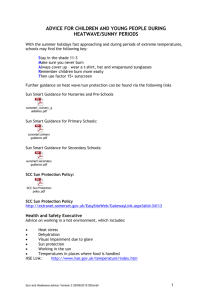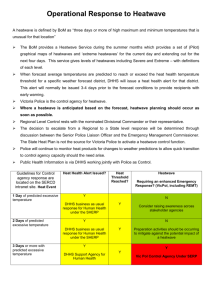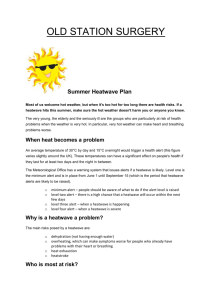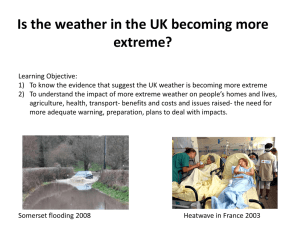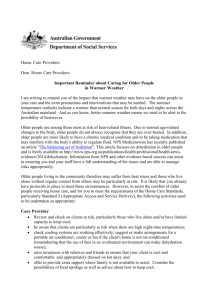Sub Plan - Latrobe City
advertisement
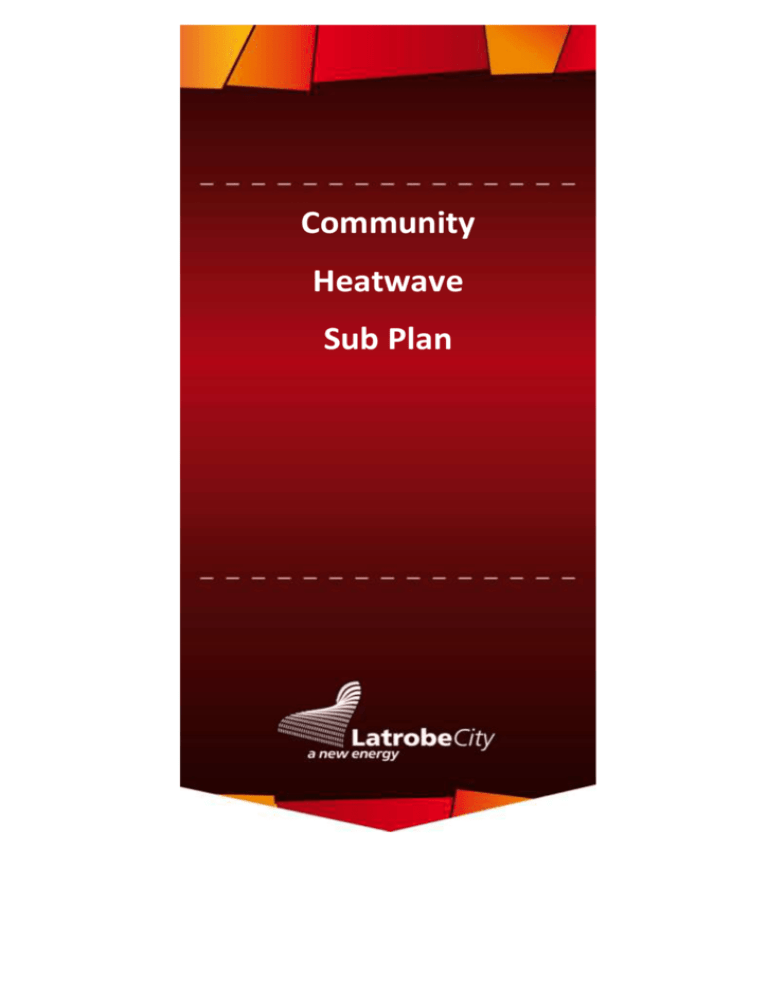
Community Heatwave Sub Plan LATROBE CITY COUNCIL HEATWAVE SUB PLAN Version Control The Latrobe City Community Heatwave Plan is a sub plan of the Municipal Emergency Management Plan. Major changes to the Community Heatwave Plan must be approved and authorised by the Municipal Emergency Management Planning Committee (MEMPC). This document will be reviewed by the Community Heatwave Sub Committee annually or after an event. Any changes to the document will be forwarded to the MEMPC for adoption. The record below is to be completed by the person making the amendment(s). Each new page will have a revision number and date of issue printed on it. Version Page Number Date Description Amended by Draft Version 1 All May 2015 Plan developed Sub Committee Version 2 All August 2015 Plan Redeveloped Sub Committee PAGE 1 LATROBE CITY COUNCIL HEATWAVE SUB PLAN Activation of this Heatwave Sub Plan Victoria’s emergency management arrangements promote the concept that emergency management arrangements are never formally activated, they simply respond and expand to meet the changing needs of an emergency. However, in the case of a heatwave there is likely to be some forewarning of an impending extended period of hot weather. At this time representatives of the control agency (Victoria Police) in conjunction with the MRM and MERO from Latrobe City Council City Council will determine the most appropriate strategy to implement the arrangements in this plan. Heatwave is defined in Section 4 of this plan (The need for a Heatwave Plan). However, in simple terms, a heatwave is an extended period where there are higher than average temperatures both during the day and at night. Possible triggers for implementation of the mitigation arrangements in this plan include: Advice from the Bureau of Meteorology or Department of Health and Human Services of an impending heatwave; The onset of above average warmer weather in the lead up to summer; A request from the control agency; A review of the risk of heatwave to the Latrobe City Council community. Possible triggers for implementation of the response arrangements in this plan include: A request from the control agency; Advice from the Health Protection Branch, Department of Health and Human Services; Identification that a heatwave is imminent or occurring; Any other circumstance as agreed by the heatwave planning sub-committee. Activation Process Upon receipt of a request, the Manager Aged & Disability Services and Manager Family Services or delegate will: 1. Follow the initial actions detailed in Section 7 of this plan. 2. Call an operational meeting of the planning committee. 3. Advise the MERO and MRM to activate the Latrobe City Council City Council emergency management arrangements as required. The following table lists the two levels of response that will be implemented by Council when notified of a Heatwave by the Department of Health. PAGE 2 LATROBE CITY COUNCIL HEATWAVE SUB PLAN Level Alert Trigger Department of Health and Human Services notification through the Health Alert System, when the Bureau of Meteorology forecasts a heatwave for at least two consecutive days. Note this could be at any time in the lead up days (day 6 to day 1 prior to a heatwave day (day 0)). Action Activated when threshold temperatures have been reached and the Bureau of Meteorology forecasts that threshold temperatures will continue for at least two consecutive days. Response All members of the Council Heatwave Committee and Emergency Management Committee notified of the forecast Heatwave and expected temperatures. Heatwave Committee meets to determine level of response required MERO to Notify Executive Team Actions listed in the Heatwave Action Plan (Section 7) will be implemented dependent upon the length, severity and nature of the Heatwave and impact on health. PAGE 3 LATROBE CITY COUNCIL HEATWAVE SUB PLAN Introduction The Bureau of Meteorology defines heatwaves as a prolonged period of excessive heat that adversely affects human health. Heatwaves are expected to increase in frequency and intensity due to climate change, ultimately causing excessive illness and death. In Melbourne, it is estimated that heat may contribute to almost 300 deaths per year amongst people aged 65 years and above. The purpose of the Heatwave Plan is to adopt a sustainable approach to the planning and response of a heatwave emergency. This Heatwave Plan is a Sub Plan of the Latrobe City’s Municipal Emergency Management Plan and has been developed in accordance with Victoria’s emergency management arrangements and the Latrobe City’s Municipal Emergency Management Plan. The implementation of this Heatwave Plan is separated into two key functions: Mitigation To educate people on the dangers of heatwaves, promote heatwave awareness, deliver key health messages prior to the onset of summer; and To reduce the incidence of heat related illness and mitigate heat related risks during the summer months. Response To safeguard the Latrobe City’s community, particularly its most vulnerable members. This stage has an emergency management focus and utilises Latrobe City’s current emergency management resources. PAGE 4 LATROBE CITY COUNCIL HEATWAVE SUB PLAN Aims and Objectives The aim of this heatwave sub plan is to document the agreed arrangements for the mitigation of and response to a heatwave that affects Latrobe City’s community. Any recovery assistance required following a heatwave will be managed using the recovery arrangements documented in Latrobe City’s Municipal Emergency Management Plan (MEMP). Mitigation This involves the education of the community about the dangers of heatwaves through: The promotion of heatwave awareness; The delivery of key health messages prior to the onset of extended hot periods such as summer, and The delivery of key health messages and safeguarded actions in the immediate lead up to an identified heatwave period. It also involves the reduction of the incidence of heat related illness and the mitigation of heat related risks during the periods of extreme heat. Response This involves the implementation of agreed strategies to support and safeguard the most vulnerable members of the Latrobe City Council community from the effects of a heatwave through: The provision of warning information; The activation of arrangements as documented in this plan to provide shelter, respite and assistance to vulnerable members of Latrobe City’s community. For the purpose of this plan, the most vulnerable members of the community are classified as people with the following characteristics: Older people (65 years and older) Children under five years old Pregnant or nursing mothers A pre-existing medical condition, such as diabetes, heart disease, kidney disease or mental illness A condition that impairs the body’s abilities to regulate its own temperature like Multiple Sclerosis Those living alone with little social contact Those taking certain medications, such as those for depression or insomnia People o With a disability o Without air-conditioning or refusing to use it o Limited access to transport o Living on the upper floors of buildings o Who are from culturally or linguistically diverse backgrounds. PAGE 5 LATROBE CITY COUNCIL HEATWAVE SUB PLAN (Source: Heatwave Planning Guide, DHS 2009) This population group has been chosen because of their prominence and vulnerability in Latrobe City Council’s demographic population and the high rate of illness experienced by this age group during the 2009 heatwave. PAGE 6 LATROBE CITY COUNCIL HEATWAVE SUB PLAN Part One - Heatwave Planning Arrangements The following key staff will form the Heatwave Sub – Committee of the Municipal Emergency Management Planning Committee (MEMPC). This group will meet at least annually in September/October each year to review and amend the plan, as well as during the summer months if the threat of a heatwave requires coordinating Council service delivery in response to the heatwave. Coordinator Emergency Management (Chairperson) Emergency Management Support Officer Manager Family Services Manager Aged & Disability Services Aged and Disability Services Coordinator Municipal Emergency Response Coordinator, Victoria Police Others may be co-opted as required to assist in implementation of mitigation and response strategies. PAGE 7 LATROBE CITY COUNCIL HEATWAVE SUB PLAN Part Two - Review and Evaluation of Plan The above group will meet annually in September/October each year to review and amend the plan. In addition, the group may meet during the summer months if the threat of a heatwave requires coordinated Council service delivery in response to the heatwave. Upon completion of development, and thereafter on an annual basis, the plan will be included in the broader MEMP for practice and evaluation through exercises. PAGE 8 LATROBE CITY COUNCIL HEATWAVE SUB PLAN Part Three - The Need for a Heatwave Plan The Victorian Government’s Our Environment Our Future Sustainability Action Statement 2006 sets out State policy in relation to heatwave planning and identifies the need for each local government to develop a heatwave plan. The Victorian Department of Health and Human Services developed the Victorian Heatwave Plan to raise awareness about the impact of heatwaves and to assist local councils to develop and implement heatwave plans. The Department of Health and Human Services has also commissioned research to: better understand the current knowledge of heatwaves; map the vulnerability in metropolitan Melbourne; develop heat thresholds; and establish a heat alert system to inform local councils of impending heatwaves. Heat and health There were 374 excess deaths during Melbourne’s heatwave from 26 January to 1 February 2009. The greatest number of deaths occurred in persons 75 years or older, representing a 64 per cent increase in this age group for this period. The effect of the heat on people’s health during the 2009 heatwave has been researched and reported. Key impacts on the health system during the 2009 heatwave are listed below. A 25% increase in total emergency cases to Ambulance Victoria and a 46% increase over the three hottest days during that period; An almost 4 fold increase in attendances to locum GP’s for direct heat-related conditions (65% in those 75 years or older); A 12% overall increase in Emergency Department presentations, with a 37% increase in those 75 years or older; (Source: January 2009 Heatwave in Victoria: an Assessment of Health Impacts, DHS 2009) The potential impacts associated with heat can be very dangerous to people’s health, and can result in illness, or in some circumstances, death. Heat-related illness can occur when the body is unable to adequately cool itself. It can range from mild conditions such as a rash or cramps to very serious conditions such as heat stroke.. Types of heat illness Heat cramps usually muscle pains or spasms, commonly occurring in the abdomen, arms or legs and may be a symptom of heat exhaustion. Heat cramps may occur after strenuous activity in a hot environment, when the body gets depleted of salt and water. Heat exhaustion is a serious condition that can develop into heat stroke. Someone experiencing heat exhaustion may appear pale and sweating. They may have a rapid heart rate, muscle cramps, weakness, dizziness, headaches, nausea, vomiting or fainting. PAGE 9 LATROBE CITY COUNCIL HEATWAVE SUB PLAN Heat stroke is a life-threatening emergency. It occurs when the body is unable to prevent its temperature rising rapidly. The symptoms may be the same as for heat exhaustion, but the skin may be dry with no sweating, and the person’s mental condition worsens. They may stagger, appear confused, have a fit or collapse and become unconscious. (Source: Heatwave Planning Guide, DHS 2009) What is a heatwave? Heatwaves are typically described as a minimum temperature over a prescribed duration that is likely to impact on the health of a community. There is no single internationally accepted definition of a heatwave as factors such as humidity, demographics, urban or rural design issues and acclimatisation mean that similar temperatures might have a different impact in different environments or communities. A heatwave threshold is forecast temperatures that are likely to impact on the health of the community. Research has been conducted using epidemiological studies on the relationship between temperature and health. For metropolitan Melbourne the Department of Health and Human Services has established a heatwave threshold as a daily average temperature of 30°C (mean of ‘today’s maximum’ and ‘tonight’s minimum’ temperature). The mean temperature for any given day is the average of the forecast daily maximum temperature and the forecast overnight minimum temperature for that day (which is the daily minimum for the following day). In these conditions, mortality rates in people aged 65 years and older might increase by 19 to 21 per cent. (Source: Heatwave Planning Guide, DHS 2009) Notification of a Heatwave The Health Protection Branch, Department of Health and Human Services will monitor the Bureau of Meteorology forecasts and send heat health alerts to communicate forecast heatwaves to local councils. Prior to a Heatwave Heat Health Alerts will be issued by the Department of Health and Human Services up to 6 days prior to the forecast heatwave. The Health Alert will advise local government to start planning the activation of the local heatwave response. During a Heatwave During a heatwave the Department of Health and Human Services may issue a further heatwave alert. The Chief Health Officer and the Department of Health and Human Services will make another public announcement or disseminate public health messages through the media regarding the current heatwave and how to stay safe and healthy. The alert will be issued as an e-mail, SMS or both. PAGE 10 LATROBE CITY COUNCIL HEATWAVE SUB PLAN Part Four - Roles and Responsibilities Role of Victoria Police (Control Agency) The role of Control Agency for heatwave is not clearly defined at this time. However the various roles of Victoria Police in emergencies, as they pertain to heatwave include: Mitigation Development of community emergency awareness through the provision of information and education in the media, and other means. Response Responsible for the effective coordination of emergency response within municipal areas. Responsible for evacuation, registration, provision of media coordination and a range of support functions. Role of the Department of Health and Human Services Before and during a heatwave, the Department of Health and Human Services will: Monitor the Bureau of Meteorology website for impending heatwaves; Provide heat alerts to local councils and departmental staff; Provide key health messages to the media and local councils; Provide communication material with key health messages; Update the State Heatwave Plan regularly. Role of Local Council The Local Government Act 1989 requires Council to improve the overall quality of life of people in the community. The Act also requires Council to provide leadership and advocate the interest of the local community to other communities and governments. The Department of Health and Human Services has recommended that Local Councils should: Ensure the Heatwave Plan is implemented and adopted; Nominate two contacts to receive heat alerts from the department; Monitor the Bureau of Meteorology website for impending heatwaves; Activate their heatwave plan when necessary; Evaluate the actions taken during heatwaves at the end of each summer season; Update the heatwave plan regularly. (Source: Heatwave Planning Guide, DHS 2009) Role of Emergency Management Organisations Latrobe City’s Municipal Emergency Management Plan sets out the roles and responsibilities of Council in the event of an emergency such as a heatwave. This plan addresses the prevention of, response to and recovery from emergencies within Latrobe City. It is the result of co-operative efforts of the emergency management PAGE 11 LATROBE CITY COUNCIL HEATWAVE SUB PLAN planning committee. The Latrobe City Community Heatwave Plan is a sub plan of the Municipal Emergency Management Plan. The Latrobe City Municipal Emergency Management Plan (MEMP) sets out roles and responsibilities of key Council personnel including the Council Municipal Emergency Resource Officer and the Council Municipal Recovery Manager. Role of not-for-profit, community and commercial organisations Council encourages all not-for-profit community groups, community and commercial service providers that deliver services to vulnerable people to develop their own Heatwave Plan. There are many not-for-profit organisations and community service providers within Latrobe City that need to ensure that they monitor vulnerable clients during a heatwave and take necessary action in the event that clients suffer heat related illness. These service providers must also ensure that their clients receive appropriate and timely information and advice in the event of a heatwave. Key stakeholders that can assist in implementing the Latrobe City Council Heatwave Plan include: Latrobe Community Health Services Community Information Latrobe City Council St Johns Ambulance Ambulance Victoria Victoria Police Disability Service Providers Neighbourhood Houses Senior Citizens Community Groups Local Hospitals Local Childcare Centres and Kindergartens Medical Centres Red Cross Salvation Army PAGE 12 LATROBE CITY COUNCIL HEATWAVE SUB PLAN Part Five - Latrobe City Heatwave Plan In Latrobe City the effects of an impending heatwave will be managed by implementation of the following mitigation strategies. Once the heatwave commences, subject to its severity, the effects will be managed by implementation of the response strategies listed below. Mitigation Strategies Promote heatwave safety information to the community Communication strategies will particularly target the most vulnerable members of the community. Strategies will include: Flyer distribution to local community groups, community care networks, children’s centre networks and kindergarten networks. Specific information flyers addressing: o Staying cool in summer o Preventing heat related illness o Keeping pets cools in summer o Keeping children cool in summer o A heatwave checklist for heatwave declared days Pre-summer information placed in Aged & Disability Services Client Newsletter. Information on the Latrobe City web site. Provide information on how to manage pets in a heatwave on the Council web site. Reminders on how to stay healthy in the heat sent out via Twitter feeds and Facebook. Provide regular contact and support to the community through Council services, particularly vulnerable community members Council home support staff to hand out heat safety flyers to their clients and discuss heat safety practices with clients; Heat safety flyers displayed on library notice-boards and within the Council Customer Service Centre. Reminders to sporting associations to refer to and adhere to their sporting association’s code of conduct and policy in relation to heatwave. Ensure Council staff are prepared to deal with a heatwave Prepare outdoor staff in the event of a heatwave through the provision of training and advice. Inform clients of possible changes to care services in the event of a heatwave (for example, earlier visit times or possible cancellation of some services). Commence delivery of Meals on Wheels earlier in the day Maintain a Vulnerable Client List of existing HACC clients, which includes clients with poor mobility, cognitive impairment, chronic health conditions, the socially isolated and those who are significantly fragile. In the pre-summer months (September to November), an increased awareness campaign will be implemented. The main aim of this campaign is to ensure the Latrobe City community is aware of the dangers of heat on their health, and are educated on mitigation techniques in preparation for the onset of possible heatwaves during the PAGE 13 LATROBE CITY COUNCIL HEATWAVE SUB PLAN summer period. This includes promoting to the community risk characteristics, preventative measures, and appropriate behaviours during a heatwave and a general understanding of personal responsibility and preparedness. Community education, awareness and support for the onset of summer Key heatwave safety messages delivered to the community will include: Drink plenty of water throughout the day. Restrict the amount of tea and coffee you drink. Keep windows and doors closed to keep the cool air inside. Wear lightweight, loose fitting clothing. Stay indoors as much as possible, or try to stay in shaded areas when outside. Take a cool shower or bath to cool your body down. A list of venues within the municipality to stay cool, including Council libraries and community centres. If you become unwell: Stop any activity and sit quietly in a cool place. Increase your fluid intake. Wet the skin with cool water or with wet cloths. Seek medical advice (your local GP or ring an ambulance) if you continue to feel unwell. Hot weather can affect all members of the community, particularly the most vulnerable elderly population. There are a number of areas in Latrobe City to keep cool and to seek assistance and medical help if required. A list of these centres can be found in Appendix 2 - Where to keep cool. This information will be posted on the Council website and distributed to vulnerable groups, as well as published in the summer issue of the Aged & Disability Services Client Newsletter. The heat safety messages will be promoted by the following methods: Media releases to the Express newspaper. Heat safety posters promoted in libraries, maternal and child health centres, senior citizen centres, childcare centres and Council’s Service Centres. Messages available on Latrobe City’s website. Home and Community Care flyer mail-out to clients. Social Support Services flyer mail-out to clients. Delivered Meals Program flyer mail-out to clients. Posting on Twitter and Facebook Promotional messages available in a number of different languages to support culturally and linguistically diverse community members. Educate stakeholders on their roles and responsibilities in the event of a heatwave Successful implementation of the Latrobe City Community Heatwave Plan is dependent upon key stakeholders understanding their role in the event of a heatwave in Latrobe City. Key stakeholders that deliver services to vulnerable members of the community should also develop their own heatwave plans. Prompt action by stakeholders will ensure the impacts of heat on the elderly and the very young are kept to a minimum. PAGE 14 LATROBE CITY COUNCIL HEATWAVE SUB PLAN Should there be advice that there is likely to be a period of sustained heatwave conditions, consideration should be given to the conduct of heatwave awareness sessions for service providers to give them advice on how to prepare for and educate their clients in heatwave mitigation strategies. Latrobe City Community Register Community Register’s have been developed across the state with financial assistance from the Victorian Government. The registers are located at police stations and staffed by volunteers. Those eligible for the register are predominantly the elderly and people with a disability. Response Strategies The Response Phase of the Latrobe City Community Heatwave Plan will be implemented when a heatwave threshold of 30°C has been reached and the Bureau of Meteorology forecasts that threshold temperatures will continue for at least two consecutive days. On days where the temperature reaches above 40°C the following actions will be implemented: Provide Council’s Customer Services with heat safety advice to assist with enquiries. Distribute heat safety fact sheets to Council departments and external stakeholders. Contact the most vulnerable members on the Home and Community Care (HACC) database. Give consideration to opening the MECC. Heatwave Response Action Plan The Heatwave Response Action Plan lists the actions that may be implemented by Council in the event of a heatwave. The decision to implement some or all of these actions will depend upon: The severity, length and nature of the heatwave; The community’s ability to protect itself from the effects of the heatwave; and Consideration may also need to be given to calling a meeting of the heatwave sub committee of the MEMPC if the predicted extent or intensity of the heatwave requires a coordinated approach. PAGE 15 LATROBE CITY COUNCIL HEATWAVE SUB PLAN Appendix 1 – Heatwave Response Action Plan Service Area Governance Actions Four staff nominated to receive heatwave alerts: Municipal Emergency Resource Officer Manager Aged & Disability Services Upon receipt notify: Customer Service Centre Municipal Emergency Response Coordinator, Victoria Police Deputy Municipal Emergency Resource Officer Council Executive Team. Manager Family Services . Meeting of Council Heatwave Committee: Community Development Council run events restricted and/or postponed: CEO/delegated officer Printing of promotional communications including flyers and fact sheets providing heatwave safety information. Ensure Council website updated to provide heat safety information and links to State and Federal websites as appropriate. Home and Community Community Care Care will identify clients Community Care will identify clients that are considered high-risk during heatwave conditions. These clients will have one or more of the following indicators: a disability , be aged and frail, living alone, socially isolated with no next of kin or next of kin who are not readily available, poor mobility, cognitive impairment, have a pre-existing medical condition, are taking medication, are without air-conditioning or refuse to use it, PAGE 16 LATROBE CITY COUNCIL HEATWAVE SUB PLAN have limited access to transport, reliant on essential Council services such as Delivered Meals or Personal Care, not case managed. These clients will be identified on the Community Care database. All Community Care clients will be provided with written information about safety in the home during heatwave conditions. Community Care services will be adapted during a heatwave to enable staff and volunteers to monitor the health and wellbeing of vulnerable clients or clients whose services have been cancelled as a result of heatwave conditions. This will comprise either a home visit or a telephone call during which advice on how to avoid heat stress will be provided. Where clients cannot be contacted, the next of kin will be notified immediately and a visit to the premises will occur to establish health and wellbeing needs Family and Children’s Services Leisure Facilities The health and wellbeing of volunteers involved in service delivery during heatwave conditions will be closely monitored. Early delivery of Meals on Wheels will commence from the first working day after Christmas and will continue until 31 March (or later depending on the season.)…………. Council’s Family and Children’s Services activities tailored and adapted, including: Outdoor activities limited between ……………??????. Staff educate d and informed of heatwav e safety practices . Extend opening and closing hours of Council run swimming pools. Communicate to all sporting clubs advising them to implement their PAGE 17 LATROBE CITY COUNCIL Public Health HEATWAVE SUB PLAN heatwave plans. Promote key health messages, developed by Department of Health and Human Services, including those in different languages. Respond to public health issues including responding to concerns of power failure from food premises. Library Services Posting of heat safety information on library notice boards. Extend hours of operation to provide a cool place for the community. Events Provide bottled water for library users. Outdoor events: Adapt times of event. Provide water to participants. If the temperature exceeds 40 degrees during the event, the event will be cancelled. PAGE 18 LATROBE CITY COUNCIL HEATWAVE SUB PLAN Appendix 2 – Places to Stay Cool If you live in a home without air conditioning or insulation and are starting to feel the effects of heat, the following public places are available for day time respite 1. Shopping Centres 2. Public Libraries 3. Senior Citizens Centres 4. Pubs and Clubs (RSL etc) PAGE 19
